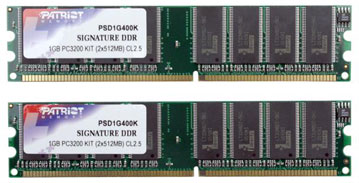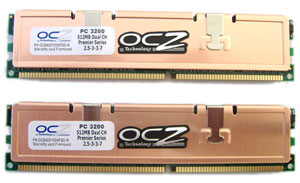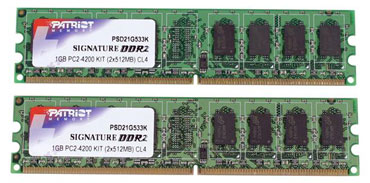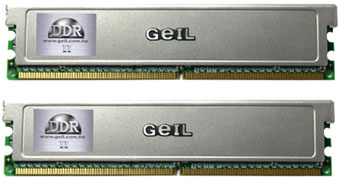Entry Level Buyer's Guide, October 2005
by Jarred Walton on October 14, 2005 12:05 AM EST- Posted in
- Guides
Memory Recommendations
We just took a look at several 1GB DIMM configurations. For the AMD socket 754 boards, it's important to remember that these are single channel memory controllers, so using two DIMMs won't help performance. Quite the opposite, in fact; some socket 754 motherboards will have problems operating two DIMMs at the fastest DDR400 speeds. We won't recommend using 2GB of RAM in a "budget" computer, but depending on price, it may be worthwhile to get 1x1GB instead of 2x512MB. It is important to note that the Intel configurations have differing RAM requirements. The office motherboard uses DDR memory, but we'll be using DDR2 for the gaming setup. Since we'll also get the benefit of dual-channel memory controllers on Intel, we chose 2x512MB packages for all the systems.
Office DDR Recommendation: Patriot Signature CL2.5 2x512MB
Price: $87 shipped (Retail)
We checked out prices on all the 1GB DIMMs in our RTPE and compared that with the prices of 2x512MB DIMMs. The difference in cost was only around $10, but generally speaking, the 512MB DIMMs had better timings for the same or lower price. (As we noted above, you would definitely want two DIMMs for the Intel Office system.) We've gone with the cheapest option, which ends up being the Patriot PC-3200 2x512MB Signature RAM. Rated at 2.5-4-4-8, the RAM isn't super fast, but the difference between this RAM and something a bit nicer like the Gaming RAM will in most instances be less than 5%. (You can likely run the RAM at 2.5-3-3-8 as well, though it's not guaranteed.) An extra $10 to $20 on every component adds up quickly, and we've tried to avoid going that route. For other alternatives, take a look at our "Gaming DDR RAM" recommendation below.
Gaming DDR Recommendation: OCZ Premier 2x512MB
Price: $95 shipped (Retail)
For the Gaming RAM, we wanted a bit more headroom for overclocking. Even though the lower memory ratios provide a lot of flexibility with Athlon 64/Sempron, it's still useful to be able to go above DDR400 speeds. We referenced our Value RAM Roundup as a guide - note that the OCZ Value VX/BH5 are no longer available without spending more money. For the best bang for the buck, the OCZ Premier at $95 is the most attractive upgrade. We managed to run this RAM at up to DDR480 with 2.5-3-3-8 timings (at 2.9V), so this should help out any overclocking attempts. CPU speed is generally king, but having a bit faster RAM is never a bad thing for performance.
Gaming DDR2 Recommendation: Patriot Signature PC-4200 2x512MB
Price: $74 shipped (Retail)
We've commented in a few other articles on the state of RAM prices, and DDR2 continues to drop. When you consider that you can get RAM capable of running up to DDR2-533 speeds for less than the cheapest DDR-400, the advantage of moving to DDR2 becomes clear. Yes, DDR2 generally has higher latency values than DDR, but there are a few architectural changes as well that make 4-4-4 DDR2 timings slightly faster than 4-4-4 DDR timings at the same clock speeds. The important thing is that getting DDR memory that can run at 533 MHz and above can cost almost twice as much as DDR2 RAM of the same speed. As with the Office DDR choice, we picked the most reasonably priced 2x512MB DDR2 offering that we could find, and once again, that was Patriot Signature. There are quite a few other manufacturers that make memory in this price range, but nearly all of them have the same specifications, and we might as well save $10. OCZ, Corsair, Mushkin, G.Skill, GEIL, and Crucial are all viable options, if you can't find Patriot RAM in your area.
Gaming DDR2 Alternative: GEIL PC-4200 2x512MB Value
Price: $86 shipped (Retail)
While technically no faster than the Office DDR2 RAM, we decided the extra $12 for the cool factor of the aluminum heat spreaders was a nice addition. (No, we don't mean "cool" as in temperatures - generally speaking, RAM heat spreaders don't actually help much.) G.Skill has some RAM with a yellow heat spreader if you're interested in more bling. Will the RAM run cooler or overclock better? Probably not, and the low CPU bus speed should make it a moot point. If you want the ability to push for even higher memory bandwidth, you could opt for some DDR2-667/PC2-5300 RAM instead. The cheapest qualifying RAM in that case also comes from GEIL, but costs $104. However, another $20 on a single component is hard to justify for this price segment.
Disclaimer: As we've said in the past, overclocking is not required. You may get an extra 20% or even 50% more CPU performance, but applications like games will often remain bottlenecked by the graphics card. For the hardcore enthusiast, overclocking can be a fun and cost-saving measure, but results are never guaranteed. If you need to ask how to overclock, you probably shouldn't do it (yet).
We just took a look at several 1GB DIMM configurations. For the AMD socket 754 boards, it's important to remember that these are single channel memory controllers, so using two DIMMs won't help performance. Quite the opposite, in fact; some socket 754 motherboards will have problems operating two DIMMs at the fastest DDR400 speeds. We won't recommend using 2GB of RAM in a "budget" computer, but depending on price, it may be worthwhile to get 1x1GB instead of 2x512MB. It is important to note that the Intel configurations have differing RAM requirements. The office motherboard uses DDR memory, but we'll be using DDR2 for the gaming setup. Since we'll also get the benefit of dual-channel memory controllers on Intel, we chose 2x512MB packages for all the systems.
Office DDR Recommendation: Patriot Signature CL2.5 2x512MB
Price: $87 shipped (Retail)
We checked out prices on all the 1GB DIMMs in our RTPE and compared that with the prices of 2x512MB DIMMs. The difference in cost was only around $10, but generally speaking, the 512MB DIMMs had better timings for the same or lower price. (As we noted above, you would definitely want two DIMMs for the Intel Office system.) We've gone with the cheapest option, which ends up being the Patriot PC-3200 2x512MB Signature RAM. Rated at 2.5-4-4-8, the RAM isn't super fast, but the difference between this RAM and something a bit nicer like the Gaming RAM will in most instances be less than 5%. (You can likely run the RAM at 2.5-3-3-8 as well, though it's not guaranteed.) An extra $10 to $20 on every component adds up quickly, and we've tried to avoid going that route. For other alternatives, take a look at our "Gaming DDR RAM" recommendation below.
Gaming DDR Recommendation: OCZ Premier 2x512MB
Price: $95 shipped (Retail)
For the Gaming RAM, we wanted a bit more headroom for overclocking. Even though the lower memory ratios provide a lot of flexibility with Athlon 64/Sempron, it's still useful to be able to go above DDR400 speeds. We referenced our Value RAM Roundup as a guide - note that the OCZ Value VX/BH5 are no longer available without spending more money. For the best bang for the buck, the OCZ Premier at $95 is the most attractive upgrade. We managed to run this RAM at up to DDR480 with 2.5-3-3-8 timings (at 2.9V), so this should help out any overclocking attempts. CPU speed is generally king, but having a bit faster RAM is never a bad thing for performance.
Gaming DDR2 Recommendation: Patriot Signature PC-4200 2x512MB
Price: $74 shipped (Retail)
We've commented in a few other articles on the state of RAM prices, and DDR2 continues to drop. When you consider that you can get RAM capable of running up to DDR2-533 speeds for less than the cheapest DDR-400, the advantage of moving to DDR2 becomes clear. Yes, DDR2 generally has higher latency values than DDR, but there are a few architectural changes as well that make 4-4-4 DDR2 timings slightly faster than 4-4-4 DDR timings at the same clock speeds. The important thing is that getting DDR memory that can run at 533 MHz and above can cost almost twice as much as DDR2 RAM of the same speed. As with the Office DDR choice, we picked the most reasonably priced 2x512MB DDR2 offering that we could find, and once again, that was Patriot Signature. There are quite a few other manufacturers that make memory in this price range, but nearly all of them have the same specifications, and we might as well save $10. OCZ, Corsair, Mushkin, G.Skill, GEIL, and Crucial are all viable options, if you can't find Patriot RAM in your area.
Gaming DDR2 Alternative: GEIL PC-4200 2x512MB Value
Price: $86 shipped (Retail)
While technically no faster than the Office DDR2 RAM, we decided the extra $12 for the cool factor of the aluminum heat spreaders was a nice addition. (No, we don't mean "cool" as in temperatures - generally speaking, RAM heat spreaders don't actually help much.) G.Skill has some RAM with a yellow heat spreader if you're interested in more bling. Will the RAM run cooler or overclock better? Probably not, and the low CPU bus speed should make it a moot point. If you want the ability to push for even higher memory bandwidth, you could opt for some DDR2-667/PC2-5300 RAM instead. The cheapest qualifying RAM in that case also comes from GEIL, but costs $104. However, another $20 on a single component is hard to justify for this price segment.
Disclaimer: As we've said in the past, overclocking is not required. You may get an extra 20% or even 50% more CPU performance, but applications like games will often remain bottlenecked by the graphics card. For the hardcore enthusiast, overclocking can be a fun and cost-saving measure, but results are never guaranteed. If you need to ask how to overclock, you probably shouldn't do it (yet).














35 Comments
View All Comments
artifex - Thursday, October 27, 2005 - link
I helped my mom get a $300 eMachines desktop at Office Depot (after rebates) earlier today. It's got a Sempron 3100+, 256MB Ram, "Unichrome" shared 64M graphics but free AGP slot, 100GB hard drive, DVDRom/CD burner, a 17 inch (16 inch viewable) CRT and some Canon Pixma printer, all in the bundle. And of course, a legit copy of Win XP, home version. I'm not supporting teaching her or my dad how to use Linux, not when this cheaper machine has XP for "free."To me, this is entry level for office or home use. Not a gaming machine, but something the average adult person can use to solve productivity needs, do word processing, etc. If she wants to, she can upgrade it to 2GB RAM later, drop in an AGP video card, buy a DVD burner, etc. I don't expect her to do anything except maybe get me to upgrade it over time to 1GB RAM and maybe a DVD burner. After Christmas, that'll be maybe $100 extra, tops. And after all, this is a $300 machine. By the time she really needs much more, in a few years, she'll be able to buy the next OEM deal for $300-400 or whatever, and this will be a secondary machine for my dad, or yet another file/media server for me, or something. Oh, and she'll have another new monitor and printer, too. Does she need PCI-E now? No. She will get more value from buying a new system 3 or 4 years from now than you will get from spending $300-400 to upgrade yours with a faster processor, mobo, and memory.
Oh, don't forget, the OEM, eMachines in this case, gets to pay to replace stuff for the next year. If I buy entry level parts from mail order or Fry's, I'll have a heck of a time getting someone to replace most of it after 90 days, without lots of mailing of parts at my time and expense. She is taking some of the money she saves to buy another hard drive to back up to, so there is hope she's not totally screwed even if the hard drive dies one day after the expiration, if she and my dad remember to back their junk up. (I have had a few Hitachis and Maxtors throw errors 13 months in, so I assume it will happen. The backup will be a Seagate, of course)
So anyway, all this rambling hopefully suggests that OEM machines can be a better deal than you think.
JarredWalton - Friday, October 28, 2005 - link
OEM systems aren't terrible, but they are lowest common denominator. I would hate to use a 256MB RAM system these days. Rebates are also something of an issue, as it can take months to get the larger rebates back, and often they'll make you jump through additional hoops - all in an effort to get you to forget (or miss the deadline for) the rebate. But yeah, a $400 PC will work well enough for many people.I have to say that personally, I don't touch such systems. If someone calls with a Compaq, Dell, HP, etc. $500 "special" and says they're having problems, I tell them that I don't work on such PCs. The reason for my stance is that people who purchase such cheap systems don't care about quality, they just want cheap. You "fix" a system like that for someone, and they'll come back to you next time a part breaks and lay the blame at your feet.
My philosophy is that getting someone to understand more about the computer hardware and buy a better product will result - long term - in a person that is happier with their computer and hopefully more knowledgeable. It's my pipe dream, I know. :)
Evan Lieb - Monday, October 17, 2005 - link
Just thought I'd pop in and say great guide Jarred. Hard to disagree with any of those components save for the speaker system, which will be overkill for a lot of home/home office users. Otherwise a superb guide. You're doing them better than I did. ;)JarredWalton - Monday, October 17, 2005 - link
Thanks Evan!Good to hear from you - where you at anyway? :p
Anyway, I like to think that anyone who doesn't want speakers will know that. It's very easy to not include them, and I also mentioned the option of free Logitech speakers with keyboard purchase. I know my office PC has some garbage $10 speakers that get the job done, and I use cheap headphones if I want "quality" (or to isolate myself).
JarredWalton - Saturday, October 15, 2005 - link
Another reader email, which mentioned something I wasn't aware of. Here it is:---------------------
Congratulations on what I found to be a very good guide - I'm sure anyone in the market for a budget PC would find it to be extremely useful.
I have just one suggested addition - my understand is that in the Sempron 64 range, the 3000+ model is the lowest one to support the Cool 'n' Quiet feature. Given that this Cool 'n' Quiet doesn't work if the CPU is overclocked, this isn't of any use for an overlocked gaming rig but may be important for those who are building a Media PC or simply would like a quiet PC.
Thank you for your consistently high quality articles and guides!
---------------------
I hadn't heard about Cool and Quiet not being on the lower end Semprons, though it would make sense. Once you're running the 90nm SOI chips at 1.6 GHz, they only consume about 25 to 30W I'd guess. Total power draw at 1.80 GHz for the 3100+ (whole system) is about 140W, but that's in a 3D intensive application with an X800 Pro GPU. The GPU looks to be using somewhere around 50 or 60W, so without the GPU you'd be well under 100W.
I guess some people would like to have added power savings, but really we're talking about $20 per year for cutting power draw by 30W, and that's running 24/7. :)
Regards,
Jarred Walton
SFF and Guide Editor
AnandTech.com
JarredWalton - Friday, October 14, 2005 - link
I received the following email from a reader, and thought some of you might find it useful, along with my response:--------------
Am in the market for a low end PC so found your http://www.anandtech.com/guides/showdoc.aspx?i=256...">latest review very
interesting.
Am wondering if you happened to note the capacitor mfrs on the mainboards
you tested.
Am asking because of cap problems http://www.badcaps.net/forum/forumdisplay.php?f=6">with even "Good Mfrs".
FYI http://en.wikipedia.org/wiki/Capacitor_Plague">this is the most complete listing I have found so far concerning "Bad
Caps".
--------------
Hi [reader],
No, I didn't look for capacitor brands - in fact, I don't have most of the parts listed in this article. It's a Buyer's Guide based off of what's on the market and prices, and performance results are not included for a reason. We have tested many of these components individually, but the parts are likely scattered across the AnandTech staff.
As far as leaking capacitors, the majority of cases occurred back in the Athlon XP/P4 and earlier days. I had at least two Pentium 3 and one Athlon XP board fail due to leaking capacitors. (The last was 18 months ago, and the first was over three years ago.) A few of those boards are still out there and are only now failing, but I haven't encountered problems with any of the Athlon 64 of socket 775 boards. Gigabyte, DFI, Biostar and ASUS should be relatively safe choices. If the board were to fail within 3 years, I believe all four companies provide at least a 3 year manufacturer warranty. (Someone else may have specific details, though.)
Regards,
Jarred Walton
SFF and Guide Editor
AnandTech.com
--------------
mino - Friday, October 14, 2005 - link
I'l definetely stick to 2500+/2800+ fo OC setup.256k IS really usefull, and I know, the benchmarks say othewise. But try doing some multitasking or any really new software titles-the newer the SW, the bigger the cachesize it is generally optimised for...
Also low multiplier is no issue if You stick to nf4 infinity where 350MHz+ base speeds are standard.
Other than that quality of Your BG's climbing steadily with time.
Keep it this way and there may soon be no place to improve:)
just kidin'...
BTW Jared:
what about to do a an multitasking test of the budget CPU's ? AT did las budget CPU test in april and roundup a bit before. Roundup of possible options that appeared snce (higher grade Semprons&Celerons + 2500+).
I will list the CPU that will be nice to have tested:
AMD
s754: 2500+,2600+,2800+(the budget trio) & some higher Sempron grades
s939: 3000+Sempron, 3000+A64 & 3700+SanDiego,3800+X2 for comparison
Intel:
s478: 310
s775: 331,351 Cellys & 506,521,630 P4's & 820 PD
as a GPU try something in the 6600/X700/X1300 range
also an 2500+@2.1GHz and 310@3.2GHz to show what budget OC could bring one
It will also show what 800FSB would give to 351 cellys and what difference 1MB cache makes.
I believe the 3.2/256/533 vs. 3.2/256/800 vs. 3.2/1M/800 could be very interesting and also pretty unique.
You should also mention that s478 Cellys start at $60 since there are sold big numbers o those and some good boards are available for 478 at bargain prices.
Power consumption test should be also present since at these prices the power consumption make huge part of the TCO.
mino - Friday, October 14, 2005 - link
Reduced test suite would be perfectly OK here also.We all know it takes _much_ time to test all those configs, but at least for Semprons You would need just one 128k&one256k chip setup thanks to lower multis option :)
JarredWalton - Friday, October 14, 2005 - link
I'm actually trying to get an overclocking article put together using a Sempron 3100+ base. Maybe I should buy a 3000+ as well, to cover the 128K variant? Hmmm... about 100 more hours of benchmarks if I add the 128K, unfortunately. :( We'll see what I can manage. It might be more than a month before I can get it all finished up.mino - Sunday, October 16, 2005 - link
Huh, 100+ hrs is huge..even so I believe that some comparison of 128k/256k 754 + 512k/1M 939 at points like:
1.6G, 2.0G, 2.4G would be really nice and pretty sufficient to show many trends.
The Celly 310@3.2G I was asking for is just to be able to see what 1M L2 and 1ML2+HT means for Prescott. Everything other being equal.
Anyway, keep on track.